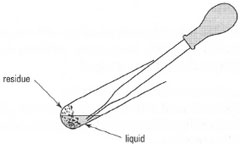Centrifugation of solutions
Centrifugation causes particulate material to accumulate at the bottom of the
test tube. The procedure for centrifuging your sample is described in Box
19.1. The speed and time of the run will depend on the centrifuge available,
but will typically be in the range 5000-10 000 rpm for 5-10 min, respectively.
Always allow the centrifuge to stop in its own time, as abruptly halting the
centrifuge will disturb light precipitates. After centrifugation, hold the test
tube at an angle so that it is easy to remove the liquid component (or
centrifugate) with a Pasteur pipette (Fig. 19.2). You will find that it is
difficult to remove all the centrifugate from the precipitate, and to maximize the transfer of centrifugate it is necessary to wash the precipitate. This is carried out as follows:
 |
| Fig. 19.2 Separation of liquid from a residue using a pipette. |
- Add a small quantity of distilled water to the precipitate.
- Use a glass rod to break up the precipitate and mix thoroughly.
- Recentrifuge the mixture.
- Transfer the liquid obtained to the original centrifugate and store this
solution for further analysis.
- Repeat the washing process, but this time discard the centrifugate, and
retain the precipitate for further tests.





